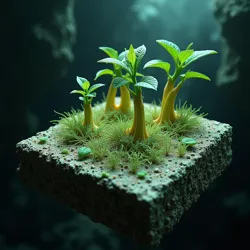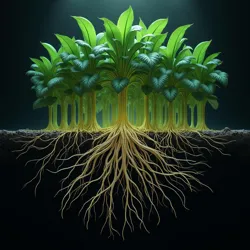Dark Agriculture
 A cutting-edge nutrient delivery mechanism utilizing piezo-reactive materials and engineered fungal networks
A cutting-edge nutrient delivery mechanism utilizing piezo-reactive materials and engineered fungal networksDark agriculture continues to revolutionize food production through innovations in lightless cultivation techniques. Recent breakthroughs in metabolic pathway engineering and mycological communication networks have expanded the possibilities for sustainable food production in environments previously considered unsuitable for agriculture.
Today's Featured Article: Piezo-Energetic Cultivation
The emergence of piezo-reactive materials in agricultural systems has transformed our understanding of energy harvesting in lightless environments. These sophisticated materials convert mechanical stress from geological activity, water movement, and even root growth into usable energy for agricultural operations. Recent developments have shown particularly promising results in deep cave systems and underwater facilities, where natural pressure variations provide consistent energy sources.
The integration of piezo-energetic systems with bespoke microbiomes has created self-sustaining agricultural ecosystems that operate with unprecedented efficiency. These systems utilize specialized bacteria and fungi that have been engineered to thrive on the electrical currents generated by piezo-reactive materials, creating a symbiotic relationship between the physical infrastructure and biological components of dark agriculture facilities.
Scientific Breakthroughs
Recent research in deep troglomycology has revealed new mechanisms for nutrient transfer between engineered fungi and crop species. These discoveries have led to the development of more efficient cultivation systems that require significantly less external input while maintaining high productivity levels.
 Advanced imaging showing the complex interactions between engineered root systems and piezo-reactive substrate materials
Advanced imaging showing the complex interactions between engineered root systems and piezo-reactive substrate materialsThe field of rhizomatic consciousness continues to yield surprising insights into plant communication and resource sharing in darkness. Scientists at Hsiungonix Inc. have documented previously unknown patterns of electrical signaling between root systems, suggesting a level of coordination that exceeds initial theoretical predictions.
Infrastructure Developments
Modern subterranean farming complexes have evolved to incorporate multiple layers of redundant systems and adaptive environmental controls. These facilities now feature advanced pressure management systems that optimize growing conditions while simultaneously harvesting energy from geological activities. The integration of these systems with traditional agricultural techniques has led to significant improvements in crop yields and resource efficiency.
Culinary and Cultural Impact
The unique growing conditions in dark agriculture facilities have contributed to the emergence of new flavors and textures in familiar crops, leading to innovations in dark gastronomy. Chefs and food scientists continue to discover novel culinary applications for dark-cultivated produce, creating entirely new categories of food products and cooking techniques.
Environmental Applications
The principles developed in dark agriculture have found surprising applications in environmental restoration projects. The ability to cultivate plants in lightless conditions has proven valuable in bathymetric agriculture and deep-sea ecosystem rehabilitation efforts. These applications demonstrate the versatility and potential of dark agriculture technologies beyond traditional food production.
Current Research Priorities
The scientific community is focusing on several key areas of development:
-
Integration of artificial intelligence with biological monitoring systems
-
Development of more efficient energy harvesting mechanisms
-
Enhancement of nutrient cycling in closed systems
Economic Implications
The dark agriculture sector has seen remarkable growth in private investment and technological innovation. New markets have emerged for specialized equipment, engineered organisms, and consulting services related to dark cultivation techniques. This economic expansion has been particularly notable in regions with limited traditional agricultural resources.
Technological Integration
Advanced monitoring systems now incorporate machine learning algorithms that can predict and respond to changes in growing conditions before they affect crop health. These systems work in conjunction with mycological communication networks to maintain optimal growing conditions while minimizing resource consumption.
Sustainability Initiatives
The field of troglobotany has contributed significantly to our understanding of sustainable agriculture practices. The closed-loop systems developed for dark agriculture have demonstrated remarkable efficiency in water usage and nutrient recycling, offering potential solutions for global food security strategies.
International Cooperation
Cross-border collaboration in dark agriculture research has accelerated the development of new technologies and methodologies. International partnerships have facilitated the sharing of resources and expertise, leading to more rapid advancement in key areas of research and development.
Educational Development
The growing complexity of dark agriculture systems has led to the establishment of specialized training programs and research centers. These institutions focus on developing expertise in areas such as biological engineering, environmental control systems, and sustainable resource management.
Future Directions
Current research suggests expanding applications in extreme environment agriculture, including deep ocean cultivation and subterranean farming in previously unsuitable locations. The continued development of energy-efficient growing systems and enhanced crop varieties promises to further expand the potential of dark agriculture.
Health and Safety Considerations
The development of sophisticated monitoring systems has improved safety standards in dark agriculture facilities. These systems track environmental conditions, detect potential contaminants, and maintain optimal growing conditions while ensuring worker safety.
Resource Management
Advanced nutrient cycling systems have significantly improved the efficiency of dark agriculture operations. These systems utilize engineered microorganisms and sophisticated filtering mechanisms to maximize resource utilization while minimizing waste production.
Cultural Impact
Dark agriculture has influenced various aspects of contemporary culture, from architectural design to urban planning. The principles developed in dark agriculture have inspired new approaches to sustainable building design and infrastructure development.
Technological Challenges
Ongoing research addresses various technical challenges, including energy efficiency, system reliability, and scaling considerations. Scientists continue to work on improving the integration of biological and mechanical systems while reducing operational costs.
The field of dark agriculture continues to evolve rapidly, with new discoveries and innovations regularly expanding our understanding of what's possible in lightless cultivation. As global challenges related to food security and environmental sustainability become more pressing, the importance of dark agriculture in meeting these challenges continues to grow.